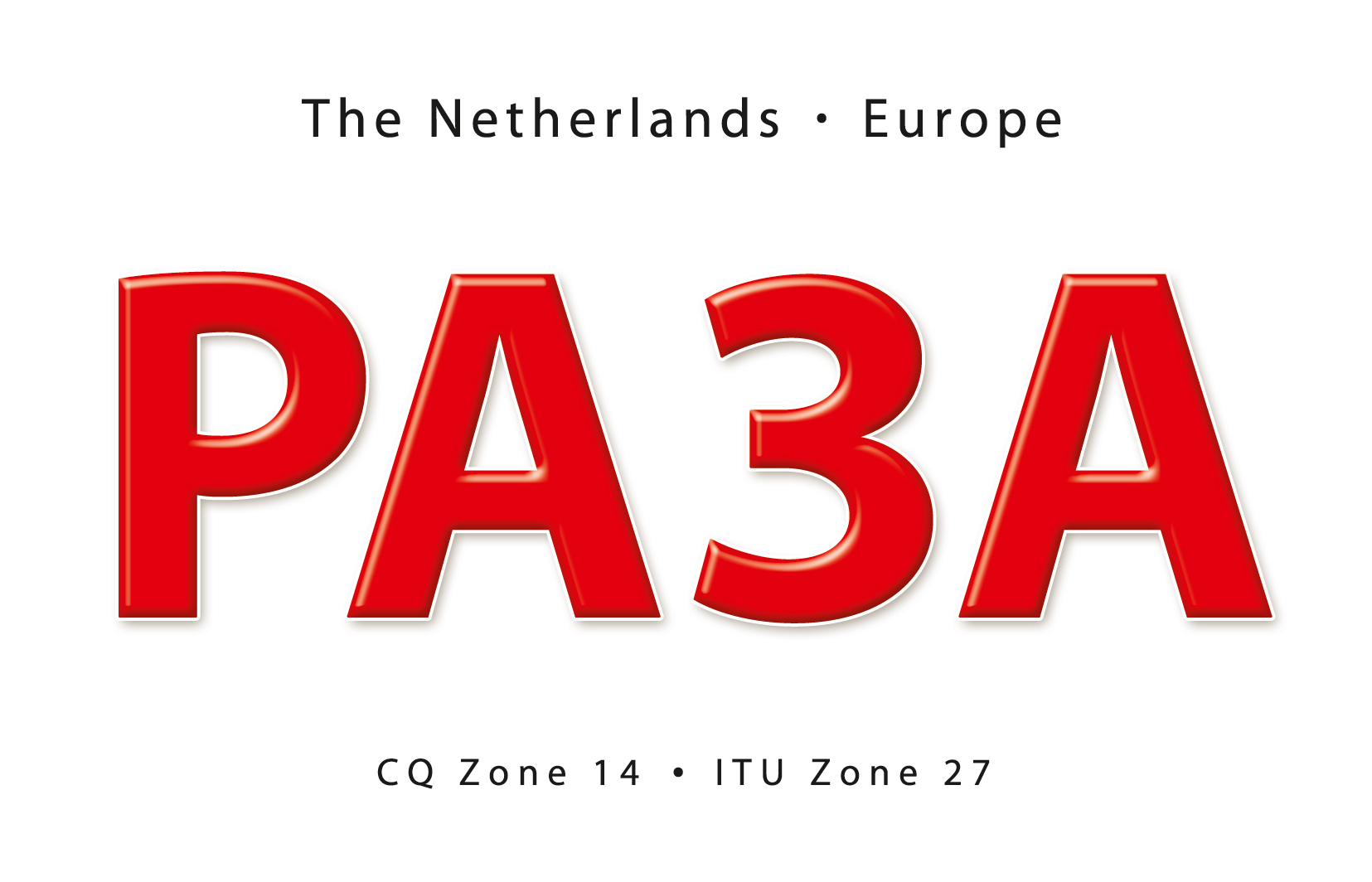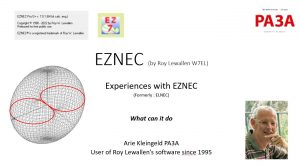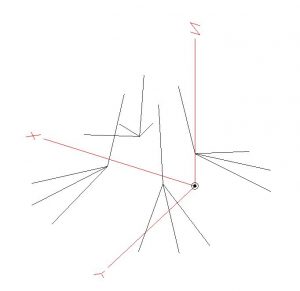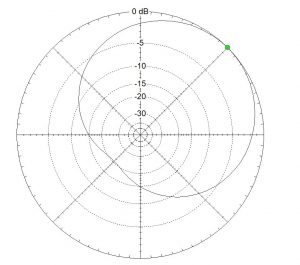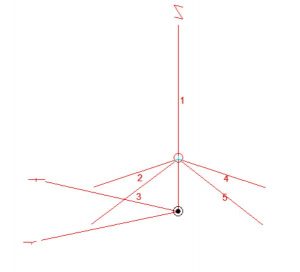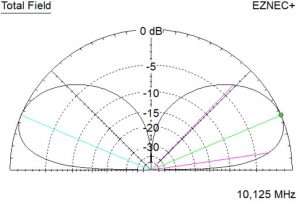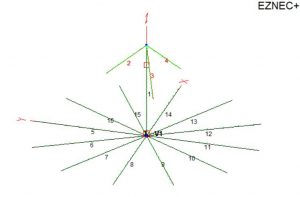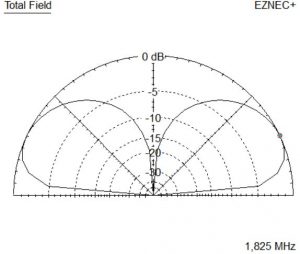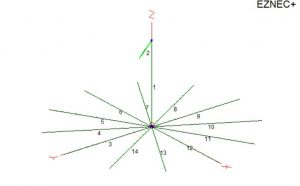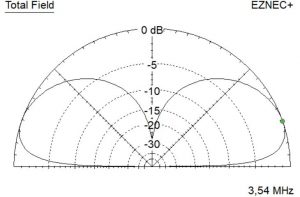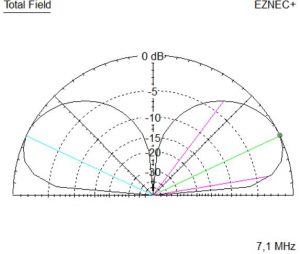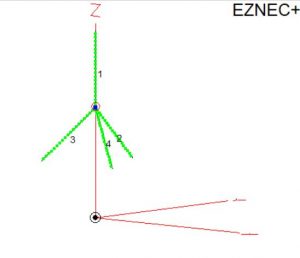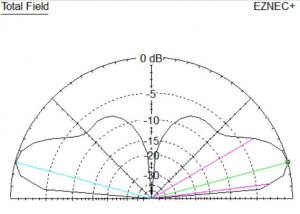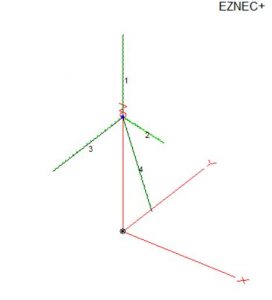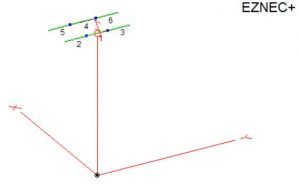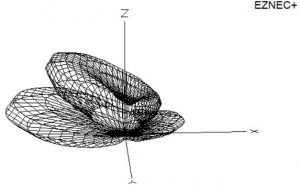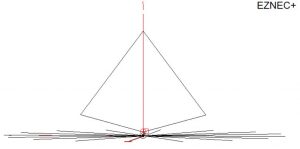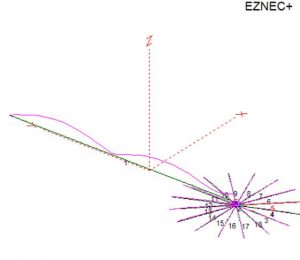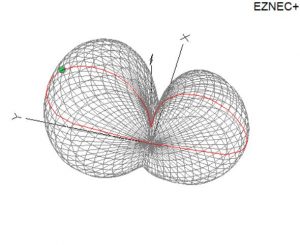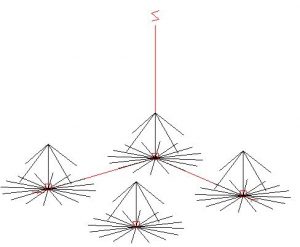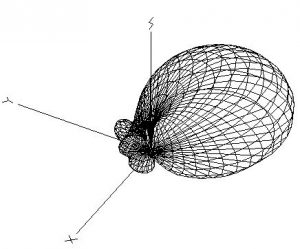EZNEC Antenna Design with  ,
,  and
and 
Antenna design with EZNEC is fun. And this fine software is for free since 2022, see https://www.eznec.com/
I started playing with ELNEC (which later became EZNEC) in the year 1995 and have done a lot of designing and checking of designs even since, upgrading to a new version once in a while and RTFM. That’s really necessary if you want to get results you can trust. I have stopped upgrading at EZNEC version 5 (NEC2-engine). It did and still does the things that I need most. There’s more colourful antenna modeling software, but I decided to stick to EZNEC. Only recent I have decided to make a page of my designs and to share some of the interesting ones of which I really have built and actually used, e.g. on DXpeditions. You’ll find simple GP’s but also 4-squares, loaded verticals, etc. The number of designs on the page will increase. I’m using the free EZNEC Version 7 now.
On this page:
- EZNEC Presentation for radioclubs
including simulations on small transmitting loops (‘magnetic loop’) - 30m 4-Square, including a complete article published in several Hamradio magazines
- 30m GP (groundplane)
- 160m Portable Vertical
- 80m Portable Vertical
- 40m Portable Vertical
- 17m GP (groundplane)
- 12m GP (groundplane)
- 6m 2-el Yagi (light weight)
- 160m / 80m K9AY Loop (receive)
- 160m Bi-directional Beverage (receive)
- 160m/80m 4-Square (receive)
- 80m 2-el Yagi designed for PA7A
EZNEC Presentation in Dutch and English Language
For beginners and for those interested in EZNEC, download the EZNEC presentation below. It may be used for presentations or talks in radioclubs with source reference.
![]() EZNEC presentation (English) PA3A
EZNEC presentation (English) PA3A ![]()
Ten behoeve van beginners met en belangstellenden voor EZNEC is de volgende presentatie / lezing beschikbaar. Neem eventueel contact op (zie contact pagina) voor een lezing.
Simulaties van small transmitting loops van de presentatie:
![]() 40m loop 1m diameter in free space without copper loss
40m loop 1m diameter in free space without copper loss
![]() 40m loop diameter 1m above normal ground and all losses included
40m loop diameter 1m above normal ground and all losses included
30m 4-vertical Array (4-square)
This array was designed and built in 2021 for a week of hamradio in LX.
One vertical of the four is RF-fed, the other three work as reflectors. It needs a simple 4 relay box to switch direction.
More info about this array, see this article: https://pa3a.nl/wp-content/uploads/2021/12/A-4-Vertical-Array-4-Square-for-30m.pdf
30m GP (groundplane)
Built for TY1MS, 9L5MS and TN2MS.
Simple and easy groundplane antenna for 30m band. It is an all wire antenna with lightweight fiberglass pole as a support. The 4 radials and nylon rope are used as guy lines.
It was used in 3 DXpeditions to Africa and on several fielddays and holidaycamps in EU.
160m Vertical for DXpeditions
This 160m vertical was designed and built for DXpeditions to Africa. It was erected in the 9L5MS, TY1MS and TN2MS DXpeditions. It worked just fine with good signals to EU, AS and NA. From 9L5MS (Sierra Leone) we could work Japan twice a day (sunrise and sundown), quite a DX.
80m Vertical for DXpeditions
This 80m vertical for DXpeditions is easy tunable for use in the 80m band. There’s a wire connected to the top as a top load. Moving the wire end up and down, so changing the angle between wire and the vertical allows for tuning the the vertical from CW to SSB portion of the band. This antenne was used succesfully in Liberia 2007 (5L2MS), Benin 2009 (Ty1MS), Sierra Leone 9L5MS (2011) and Rupublic of the Congo TN2MS (2013).
40m Vertical for DXpeditions
This is a straightforward and simple design. All wires are 10m long. The radiator can be a bit shorter than a quarter wavelength because insulated wire is used (PVC coating). A thicker pvc-coating implies a shorter vertical.
The radiator is strapped onto a light weight fiberglass pole. To keep the pole in its position, 3 (nylon) guy wires are needed.
16 radials are flat on the ground. As a result, the groundscreen system is not resonant.
17m GP (groundplane)
A straight forward portable groundplane antenna. Height above ground is chosen for a low angle take off of the signals. Radiator is tied to a light weight 10m long fiberglas pole. The three arms of the groundplane plus some nylon cords are used as guys, tied to the ground with plastic tent pins.
Because of the KISS principle (Keep It Stupid Simple) and the very light set-up, this antenna is ideal for DXpeditions or fielddays.
Length of all wires: 3,42m
All wires are covered with pvc coating. EZNEC calculations can be redone without the coating if you like. Antenna design with EZNEC is fun indeed.
12m GP (groundplane)
KISS (Keep It Stupid Simple) portable groundplane for the 12m HF band.
Height above ground is set for a low take off angle.
The radiator can be tied to a fiberglass fishing rod or leight weight fiberglass pole. Radials are tied to nylon cord and used as guy lines.
Groundplane antennas like this are ready within 10 minutes.
6m 2-el Yagi
We got this from Nuxcom.de as a kit. It was sponsored to TN2MS in 2013. Nuxcom’s antenna materials are discontinued.
- Portable 6m beam, 2 thin and tapered alu-elements
- Boom is PVC pipe
- Boom-to-mast plate also PVC
- As connecting clamps from boom-to-mast we used tie-wraps!
- Total weight less than 500 gr!
A thin 10m long fiberglass pole was used as a mast. Antenneheight was set at about 6m. The beam was used in Republic of the Congo (TN2MS 2013) with good results during openings. QSO’s with AS, EU and NA in the afternoon / early evening.
160m K9AY Loop (receive)
This loop was built for Africa DXpeditions to Sierra Leone (9L5MS 2011) and Republic of the Congo (TN2MS 2013) and it was used in several field days in EU.
Directivity of a single loop is ‘only’ 7,5 dB. The performance in Congo was not as good as we had hoped. Because of the very high QRN level reception was difficult. This is not strange because Congo is in the world top 5 countries with most thunderstorms within its borders. We were able to get out of Africa with the 160m vertical (see the design on the page), but reception was another thing: S9 +20dB continuous QRN on the vertical and hardly significant better S/N ratio on the K9AY to hear the reported pile-up. It works OK in EU, but it is still not a super RX antenna unless you use an array of 2 or more phased K9AY loops.
Use on 80m: the loop can also be used on 80m. Directivity on this band is about 7,3 dB.
There are a lot of websites with data of this loop. Size of the loop in the EZNEC file is the same as on all those sites.
160m Bi-directional Beverage (receive)
This bi-directional beverage was built for PI4D of the Dordrecht Radio Club. About 2m above the ground, held bij low treebranches, and 170m long. For the NEC-2 engine of EZNEC, the ground connection at the feedpoint is modelled by a radialset (16 x 40m at 1cm above groundlevel). Currents on the beverage are also visible in the picture.
The bi-directional beverage performs quite well. There’s a sharp dip in the plot perpendicular to the wire of the beverage. It is quite noticable in the real world too. That’s why two beverage antennas were erected perpendicular to each other for switchable N-S and E-W reception. These long wires are easily found by non-hams and are also susceptible to damage.
160m/80m 4-Square (receive)
This receive array was built for a DXpedition to Sierra Leone. Lack of space prevented the use of this array there.
Still I used it as a portable setup in 160m contests at several stations in the Netherlands for good reception.
All used wires (vertical, top load and radials on the ground) are 7m long. Size of array: 20m x 20m (radials on ground excluded)
The 4 toploaded verticals in this simulation are base-loaded with 39 uH to resonate them on 160m, also a 72 ohm resistor to get the impedance of each vertical to about 75 ohms.
These are values in A SIMULATION. The values differ a bit in the real world, in my case 33 uH resonated the verticals to 160m (X=0 on the analyzer). To get the antenna in the field to show R=75 on the analyzer, I used a small trimpot of 100 ohm and turned it until R=75 on the analyzer. Measurement was done directly at the base with a 15cm short 75 ohm coax. Fine tuning of the resonance frequency can be done by changing the tilt of the topload wires.
Receive 4-square vor 80m.
Note that without the 33 uH inductance the same 4-square can be used on 80m.
Dimensions, loads, phasing/delay lines, transformers etc are in the EZNEC description.
Not in the model is the 75 ohm coax from central switch to each vertical (4 x 15m)
Directivity of the array in the simulation: 11.7 dB, about the same as a 1 wavelength beverage.
F/B ratio: > 20 dB
Beamwidth: < 90 degs (when elevation under 45 degs)
————————————————————-
This antenna system is based on a design of Tom, W8JI. ( http://www.w8ji.com/small_vertical_arrays.htm )
Also crossfire-phasing is used. (http://www.w8ji.com/crossfire_phasing.htm )
There’s also an interesting article about this subject by Louis IV3PRK. (http://www.iv3prk.it/user/image/site2-rxant.prk_4-square_1.pdf )
————————————————————–
2 element 80m beam with short boom
An 80 meter 2-el yagi on 8m boom, designed for PA7A at his request. The elements are tapered.
The resonance frequency of the model in EZNEC was 10 kHz off the real one. See PA7A’s page on QRZ.com for the beam in real life.
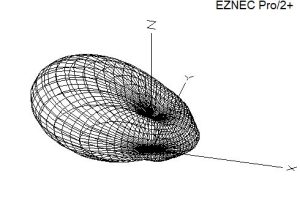
![]() 80m 2el for PA7A Refl op 8m boom
80m 2el for PA7A Refl op 8m boom
